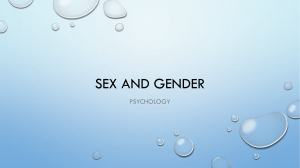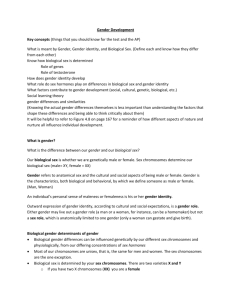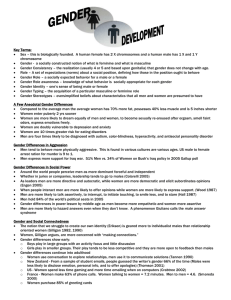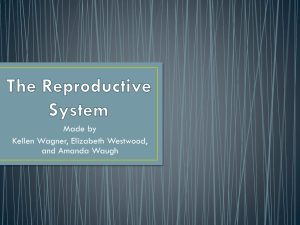PSYB
advertisement
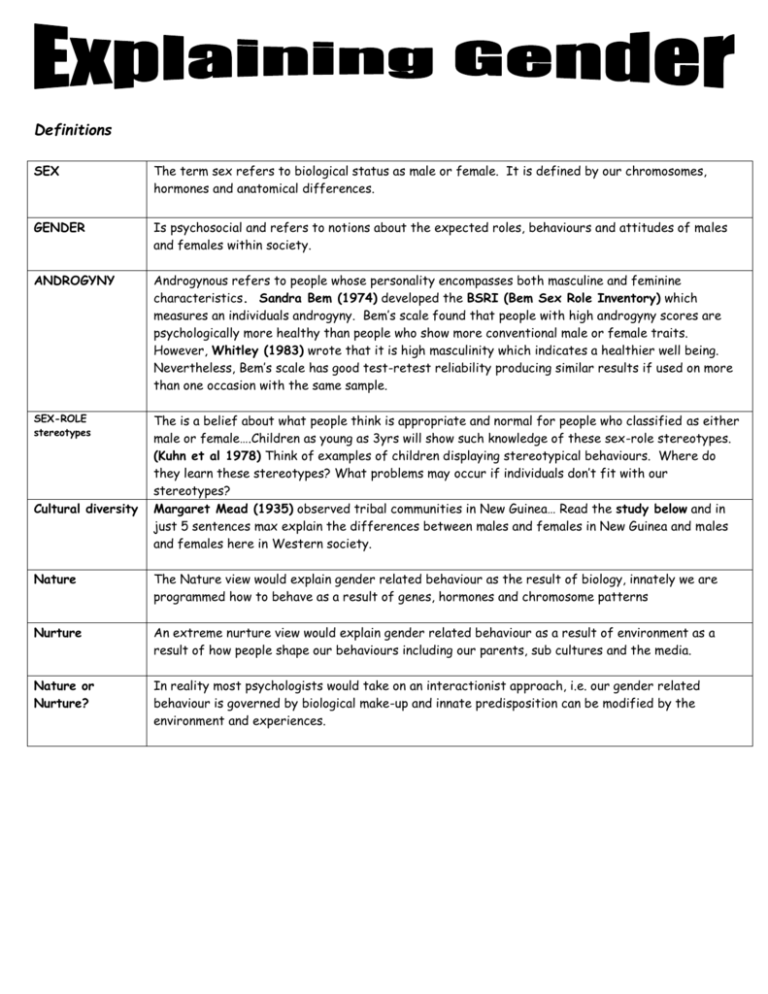
Definitions SEX The term sex refers to biological status as male or female. It is defined by our chromosomes, hormones and anatomical differences. GENDER Is psychosocial and refers to notions about the expected roles, behaviours and attitudes of males and females within society. ANDROGYNY Androgynous refers to people whose personality encompasses both masculine and feminine characteristics. Sandra Bem (1974) developed the BSRI (Bem Sex Role Inventory) which measures an individuals androgyny. Bem’s scale found that people with high androgyny scores are psychologically more healthy than people who show more conventional male or female traits. However, Whitley (1983) wrote that it is high masculinity which indicates a healthier well being. Nevertheless, Bem’s scale has good test-retest reliability producing similar results if used on more than one occasion with the same sample. SEX-ROLE stereotypes The is a belief about what people think is appropriate and normal for people who classified as either male or female….Children as young as 3yrs will show such knowledge of these sex-role stereotypes. (Kuhn et al 1978) Think of examples of children displaying stereotypical behaviours. Where do they learn these stereotypes? What problems may occur if individuals don’t fit with our stereotypes? Margaret Mead (1935) observed tribal communities in New Guinea… Read the study below and in just 5 sentences max explain the differences between males and females in New Guinea and males and females here in Western society. Cultural diversity Nature The Nature view would explain gender related behaviour as the result of biology, innately we are programmed how to behave as a result of genes, hormones and chromosome patterns Nurture An extreme nurture view would explain gender related behaviour as a result of environment as a result of how people shape our behaviours including our parents, sub cultures and the media. Nature or Nurture? In reality most psychologists would take on an interactionist approach, i.e. our gender related behaviour is governed by biological make-up and innate predisposition can be modified by the environment and experiences. AIM Mead (1935) conducted a cross-cultural study of three societies to investigate whether there were differences in gender roles which could suggest that gender was a product of environment rather than biology. METHOD She visited three tribal communities on the island of New Guinea for a period of six months. The Arapesh lived in the mountain region, the Mundugamor lived by the riverside and the Tchambuli lived on the lakeside. She observed and recorded the behaviour of people within these groups for comparison with traditional western culture. RESULTS The Arapesh showed personality traits and behaviours similar to those found in western society although they were more interested in the community than perusing individual goals. The Mundugamor were described as fierce and cannibalistic. Both males and females displayed traits which were described as masculine. The Tchambuli had distinctive gender roles, but the reverse of those in the west. Men were more artistic and women held the social and economic power. CONCLUSION There is no inevitable relationship between biological sex and gender role. Culture is the major socialisation agent, particularly in the early years. EVALUATION Anthropologists have criticised Mead’s work since her work lacked scientific thoroughness as she was young at the time of research and so had little life experiences which may have clouded her perceptions of what she observed. The fact that Mead only spent 6 months with these communities is also a problem. Errington and Gewertz (1989) revisited the Tcambuli and re-analysed Mead’s work. They recorded that the women do not dominate the men and nor is the reverse true. nurture Nevertheless, asides from flaws in methodology, cross cultural research has stimulated the argument towards the nature when defining gender roles. There are three main biological explanations of gender behaviour Chromosomes Hormones Brain structure 1 Chromosome differences The normal human body contains 23 pairs of chromosomes. Each pair of chromosomes carries genes that control different characteristics. Biological sex is determined by the 23rd pair. So females have the genotype XX and males have the genotype XY. Both males and females begin as an egg carrying an X chromosome. If the egg is fertilised by a sperm carrying an X chromosome then the embryo will develop as a girl and the two gonads will become ovaries. At the beginning the embryo will always have male and female interior anatomy but the male elements spontaneously disintegrate while the female ones thicken and grow into a womb. At the same time, the exterior anatomy, which has the same beginnings for both sexes, develop into female genitalia and the result is a girl. As we shall see, even without ovaries, development follows the female route: the natural route of the human is the female one. To become male means interfering with that route. If the egg is fertilised by a sperm carrying a Y chromosome then the gonads develop into testes. They pump out the hormone that which actively absorbs the female parts which would have otherwise begun to grow, and then the gonad produces the major male hormone testosterone. This stops the male parts disintegrating; it thickens the spermatic cord, and switches the genitalia away from the female route. The result is male. Atypical sex-chromosomes Any combination of sex chromosomes other than XX or XY is seen as atypical. Klinefelter’s and Turner’s syndrome are examples of conditions which result from atypical sex chromosome conditions. Klinefelter Syndrome (XXY) Turner Syndrome (XO) Caused by the presence of an extra Caused by the absence of an X X chromosome chromosome Biological male with a physical appearance of male Biological female with the female external appearance Affects between 1 in 500 and 1 in 1000 males Affects 1 in 2500 Psychological effects: poor language skills – which affects reading ability, passive temperament Physical effects: less body hair than normal male, underdeveloped genitals, long legs in relation to torso, infertile Psychological effects; higher than average reading ability; lower than average spatial ability, visual memory and mathematical skills; difficulty is social adjustment Physical effects; ovaries fail to develop, short squat body with webbed neck What does studying people with atypical sex chromosome patterns allow us to conclude what about gender? It provides evidence that our biological makeup might be responsible for gender-related behaviour. For example, by comparing someone with typical chromosomes with someone with atypical chromosomes you can make clear comparisons what aspects of their behaviour have a genetic cause. Studies to support the fact that chromosomes do affect an individuals gender related behaviour Imperato McGinley et al (1974) The Batista family Imperato-McGinley and her colleagues studied some unusual families including the Batista family from three villages in the Dominican Republic. Thirty seven children studied by the researchers had inherited a mutant recessive gene from an eighteenth century ancestor. They were born with apparently female genitals and were brought up as girls even though they all had XY chromosomes. When they reached puberty, the surge in testosterone levels, led to the production of a male hormone (dihydrotestosterone) which they had lacked before birth. This hormone led to their rather belated masculinisation and the sudden development of male genitals. They were born with normal female genitalia and body shape, but when they were twelve, their vaginas healed over, two testicles descended and they grew full penises. So the little ‘girls’ grew up to be muscular men. Curiously these people reported no difficulty in adopting the male gender despite being reared as girls. They adapt their new gender identity well to their new sex, take men’s jobs, marry women and are treated as men by others. So the role of socialisation in the development of sex roles appeared to be overridden by biological factors and the researchers concluded that biology was all important. Their ability to adopt a male gender identity and gender role suggests that their testosterone had pre-programmed masculinity into their brains. However, one problem with this study was that the genitalia of these ‘female’ children were not entirely normal and others knew this from communal river bathing. It may be that the rearing of these children was not the same as that of normal females, especially as villagers would have known of other children with this disorder. It is also possible that the young men had no difficulty in adjusting to their new gender because they had always been uncomfortable with the female role. Certainly they were given support by their community to make the transition. This clearly suggests environmental influences on the children’s gender identity This study aims to prove how the environment is all that is necessary to determine an individuals gender identity Money and Erhardt (1972) The David Reimer story Money and Erhardt proposed the theory of neutrality, stating that children are born gender-neutral and suggested that gender reassignment will be successful if carried out before the child is three years old. However, one famous study showed this was not the case. These researchers studied a pair of identical twins with the aim of finding out whether nurture, that is, how a child was reared, could overcome his genetic inheritance or nature. The method chosen was the case study. This is a rich and detailed study of one individual, or a small group, such as a family. Such studies involve observing and interviewing people as well as studying any records there may be about the participant. Case studies are sometimes carried out because it would be unethical to carry out an experiment to test a particular hypothesis. It is not unusual for people with rare medical conditions or even those who have been victims of surgical or other accidents to be studied in this way. They studied monozygotic (identical) twins who were both normal boys when they were born. However, at the age of seven months, one was tragically injured during circumcision. This is a common operation to remove the foreskin from the penis and can be done for either religious or medical reasons. The damage was so severe that when the boy was twenty two months of age the parents decided to accept medical advice and to rear him as a girl. The child then underwent castration and plastic surgery so that her genitals resembled those of a girl. The doctors planned to give her female hormones when she reached puberty to help feminise her appearance. The little girl and her parents visited the clinic annually for support and guidance. The child was observed during these meetings and the mother also provided reports of her progress. The mother encouraged her child to dress in a feminine fashion and tried to treat her as a girl. Initially the results of this gender reassignment seemed promising. Only one year after her operation, the girl twin clearly preferred to wear dresses rather than trousers and was proud of her long hair. By the age of four she was happy to sit to urinate and was cleaner and neater than her brother. At five the child asked for sex typed toys for Christmas such as a doll and a dolls’ house whilst her brother wanted cars and tools. She was encouraged to help her mother with the housework whilst her brother ‘couldn’t care less about it’. The twins had different career ambitions, too. The girl wanted to be a doctor or a teacher whilst the boy wanted to be a fireman or a policeman. At nine years of age she was quieter and more ‘lady like’ than her twin. Her brother was reported to be protective of her, whilst ‘she’ was said to be a ‘fussy little mother’ to him. However, the girl also showed ‘tomboyish’ behaviour in that she had lots of physical energy and was apt to want to dominate other children. On the basis of this and other cases Money and Ehrhardt came to the conclusion that during the first three to four years of life gender reassignment can be easily carried out. This evidence supported the idea that gender role is learned. However, the castration and treatment with female hormones would also have helped her to adopt her new gender. Sadly after Money and Erhardt had completed their study, the child was followed up by another researcher who proved that biology has the greatest influence on gender. Diamond (1982) Diamond found that at the age of thirteen the girl was ‘beset with problems’ (Berk 1989). She found it hard to make friends in adolescence and was unhappy. Although she had been treated with oestrogen (a female hormone) she still looked rather masculine. She ‘seemed ambivalent about her gender status’, that is, not sure whether she was male or female (Berk 1989). She believed that boys had a better life than girls and she wanted to be a car mechanic. Diamond concluded from this follow up study that people’s biology largely determines their gender. The Money case raises ethical issues. The parents believed they were doing what was right for the child and were acting on expert advice. The boy ultimately felt he had been mistreated and that his results had been misrepresented to fit with the researchers beliefs. PAST PAPER QUESTIONS Identify one atypical sex chromosome pattern and outline how it might affect an individual. Name one sex hormone and give an example of how this hormone might affect a person’s behaviour. (3 marks) (2 marks) Victoria is five years old and she is different from other girls of her age. She is smaller in height and has a webbed neck. At school, her teachers have commented that she has good verbal skills but her mathematical skills are poor. Medical tests have revealed that Victoria has a sex chromosome pattern XO. Name the atypical sex chromosome syndrome described above. (1 mark) Identify how Victoria’s sex chromosome pattern differs from that of most girls. (1 mark) Explain how studying people like Victoria can contribute to our understanding of gender. (2 marks) Give the typical sex chromosome pattern for the following: a male a female (2 marks) 2 Hormonal differences Hormones are chemical substances secreted by glands in the body. Men and women have the same sex hormones, just in different amounts. Male hormones are collectively known as androgens and the most well known of these is testosterone. While male and female hormones have obvious physical effects, psychologists are interested in the effects of sex hormones on behaviour. Different levels of aggression have been found in males and females. As a consequence much research has focused on the role of testosterone on behaviour. Testosterone is a predominantly male hormone that affects development and behaviour both before and after birth. In the 5th month of foetal development, the male gonads secrete testosterone causing the male foetus to develop external sex organs. The psychological effects can also be seen in a condition known as CAH (Berenbaum and Hines, 1992). This is where you would explain this case… Laboratory studies of animals have showed that testosterone does lead to increased aggression (Silber and Wagner 2004): Male rats show more aggression than female rats Castrated males show reduced aggression Male-male aggression begins at puberty when male hormones are secreted Aggression increases with injections of testosterone, since Von de Poll et al found that injecting female rats with testosterone led to increased aggression. Studies with men taking bodybuilding androgenic steroids show that they have higher than normal levels of aggression on questionnaire scores. However, it is impossible to determine cause and effect in such studies. For example some of the participants worked in occupations including security staff and bouncers which may be viewed as aggressive in nature. Perhaps their work was the cause of the aggression not the steroids. Research with prison populations has also been used to determine a link between testosterone and offending, which is presumably aggression. Dabbs et al (1995) wanted to find out if there was an association between prisoners’ behaviour, the types of crimes they had committed and their testosterone levels. They measured the testosterone levels of 692 male offenders in prison by testing saliva samples. They looked at the prisoners’ records and coded the prisoners according to the type of crime they committed and the extent to which they had complied with prison rules. They found that men with higher levels of testosterone were more likely to have carried out violent and sexual offences than men with lower testosterone levels. The latter were more likely to have committed drug offences and burglary. Prisoners who had higher testosterone levels were also more likely to have broken prison rules. It was concluded that testosterone causes heightened arousal and aggressive behaviour. This could explain why men are more likely to be aggressive than women, as they have higher testosterone levels. They concluded that testosterone may be linked with aggression. The problem with the studies so far is that they are based on naturally occurring phenomena which means it is difficult to establish a cause and effect i.e. we do not know if testosterone alone is the only factor that causes aggression….there could be other confounding factors that we cannot control for. To discover more valid results we must complete an actual experiment. Therefore Tricker et al (1996) conducted a study to eliminate confounding variables. In a double blind study 43 males aged between 19 and 40 years received either 600mg of testosterone or a placebo. Neither the participants nor the researchers knew who was receiving the drug or the placebo. The study lasted for 10 weeks and participants were tested before, during and after treatment using two anger questionnaires which investigated their aggressive behaviour. The results showed that there were no significant differences found between the experimental and the control group on any of the measures over the 10 weeks. In other words high levels of testosterone have no effect on aggressive behaviour or attitudes of the males. General evaluations of testosterone research…. Increased levels of T may be a consequence of aggressive behaviour rather than the cause. It might not be appropriate to generalise from animal research findings to human behaviour. Explaining aggression purely in terms of chemical activity is perhaps an oversimplification. Environmental factors like family background also influence how people respond to frustrating situations. Most males manage to control their behaviour and behave in socially acceptable and non-violent ways. The effect of T may be indirect: males with high testosterone might have more muscular bodies, which might lead others to treat them as if they are aggressive. Perhaps it is the way other people response to them that leads them to be aggressive – the self fulfilling prophecy. Female Hormones Oestrogen is a female hormone, responsible for the development of female sexual characteristics and menstruation. In addition to physical changes which occur in the body due to oestrogen, some psychological and behavioural effects have been reported. In some women it causes pre menstrual syndrome PMS (sometimes known as premenstrual tension or PMT). This can sometimes lead to feelings of emotionality, irritability and even aggression. It has also been suggested that it could be responsible for momentary lapses of self control or attention leading to antisocial behaviours such as committing criminal acts. Even though it is debatable whether crime can result from PMS this has successfully been accepted as a mitigating factor in the defence of women tried for shop lifting and even murder (Easteal, 1991). However, Golombok & Fivush (1994) summarise the results of the investigations into the effects of oestrogen and psychiatric symptoms in the pre menstrual period and during the menopause. They conclude that there is no consistent evidence that changes in oestrogen levels are responsible for the depression, anxiety or irritability that women report. They suggest that where these symptoms are carefully measured, for example using daily records, they are found to be less evident than when reported individually. Evaluations Some evidence supports the view that biological differences between males and females affect behaviour however the evidence is usually inconsistent so not significant enough to make firm conclusions In other words, even if biology has a role, it is always important to consider environmental factors. 3 Differences in brain structures Differences in the organisation of male and female brains result from the effect of testosterone before birth. There are two hemispheres in the brain which are linked by the corpus callosum. The left side of the brain is specialised for language and the right side of the brain for spatial skills. Males tend to use each side of their brain separately whilst some research suggests that females may have a denser corpus callosum and tend use both hemispheres simultaneously. According to Mc Glone (1980) the right hemisphere is generally more dominant in men and the left in women. However much research is still required in the field of sex differences and cognitive ability in relation to the corpus callosum before any direct conclusions can be made. In conclusion Biological psychologists believe sex differences are innate (inborn) and that we are biologically ‘programmed’ to act in certain ways or to have sex-typed abilities which then leads to the male and female gender roles. For example, Eysenck points out that the greater strength and speed of males is biologically determined (caused) and is seen in their ‘instrumental behaviour’ such as fighting and hunting. Similarly, females give birth to and breast feed their infants and so it is important that they are caring which would explain why biological factors may also underpin female ‘expressive behaviour’ (Eysenck 1996). Some differences between males and females occur very early in life before learning has had time to take place. You should list some examples here…. Many sex differences are remarkably consistent from one culture to another. As people from very different cultures have their biology in common it may be that chromosomes and hormones are responsible for these cross cultural similarities. Behaviours such as aggression differ not only in men and women but also in the male and female members of other species. This also suggests that biological features which we share with other animals may be involved. Biological explanations of gender are reductionist. This means that they try to explain complex behaviours in terms of a single cause when it is likely that a number of factors are involved. ‘Nature’ or biological explanations of gender ignore social and cultural factors, in other words, the role of nurture. The genetic differences between males and females are not huge. It is only one pair of chromosomes which differs, after all, and the Y chromosome, unique to males, actually contains the least genetic material. Even if hormones do influence behaviour, this doesn’t mean that such behaviour is inevitable. People can make choices about how they will behave. Other studies to support biological explanations of gender Case 4: Adrenogenital syndrome (AGS): Money and Ehrhardt 1972 This is where a female with the normal genotype XX has been exposed to excessive levels of androgens (male hormones) during the critical period of prenatal sexual differentiation. Therefore, the internal reproductive structures are unaffected, but the external structures resembled those of a male infant. For example, an enlarged clitoris appears as a penis. This happened because either some of the mothers of these babies had been given a hormone to stop them from having a miscarriage or some baby girls had a genetic disorder which prevented their adrenal system from functioning normally. Many people with AGS are declared boys and raised as boys. Since their hormonal surge continues, their voice deepens and face and body hair sprout at puberty. These people with AGS grow up as normal men; they feel male and pursue women romantically. They can have intercourse as men and become good husbands and fathers (by adoption or artificial insemination). Money and Ehrhardt studied girls with AGS who were raised initially as boys as soon as the mistake was found, their genitals were surgically corrected and they were reassigned and raised as girls. They found that although these children were treated as girls by their parents, they were tomboyish in that they preferred to play with boys and fight. They disliked the activities traditionally seen as feminine. Nevertheless Money and Erhardt concluded that androgens (male hormone) have an important role in determining sex typed behaviour. Case 5 Mr Blackwell: Hermaphrodite (Goldwyn, 1979) Goldwyn cites the case of Mr Blackwell, only the 303rd true hermaphrodite in all of medical history (where person’s cells are both female XX and male XY). He’s described as a handsome and rather shy 18 yr old boy. Although he had a small vaginal opening as well as a penis, he was taken to be a boy and brought up as such. But when he was 14yrs he developed breasts and was sent to hospital to discover why this had happened. It was found that he had an active ovary on one side of his body and an active testicle on the other. Gross (1987) suggested that in fact he could well be said to have a ‘female brain’ for his hormone system was enough to take him through the whole female cycle and ovulate every month. Nevertheless, he expressed his wish to remain male and so his female parts were removed. His upbringing as a male seems to have been a major influence on gender development. This case then underlines the strength of nurture, since his upbringing as a boy influenced his gender identity as a male, OVERIDDING his female bio chemistry. Also the surgeon who had carried out the operation on Mr Blackwell, and on 25 other similar cases – all these people had no doubt about their gender, which was always in line to how they were raised – male or female. It therefore seems that biology alone can not determine gender development. EXAM QUESTION Discuss biological explanations of gender development. Refer to at least one study in your answer. (10 marks)
